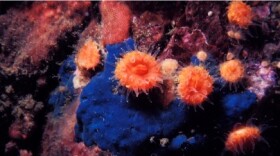Washington’s Department of Natural Resources will soon release a draft environmental impact statement on its long-term strategy for the marbled murrelet. But some conservation groups are crying foul.
The marbled murrelet is an elusive seabird that’s listed as a threatened species under both federal and state law. It nests in old growth forests and DNR’s document outlines six options to help the bird survive. But the agency still needs to meet its constitutional mandate of generating revenue for schools through logging.
Several conservation groups are raising concerns about the state’s plan. Peter Goldman is director of the Washington Forest Law Center.
“It is ill advised for the Department of Natural Resources to be releasing an environmental impact statement at this time because the DNR is essentially tying the hands and making decisions on behalf of future decisions makers,” Goldman said.
Goldman echoed that sentiment in testimony delivered Tuesday at a meeting of the agency's board.
He says the murrelet plan has been in the works nearly eight years and the department should delay its release till the next lands commissioner and new members of the DNR board take up office.
Goldman and others say a seventh option is needed, to provide more protections for the old growth forests where murrelets nest. But DNR Deputy Supervisor Kyle Blum, who has worked on the murrelet strategy for about five years, disagrees.
“I mean, if I was a new administration, wouldn’t it be great to come in and within my first few months get all of this comment. That’s a perfect landscape from which to digest information from staff, digest information from the public and then set a course of action moving forward,” Blum said.
Blum says the six options presented provide a full range of conservation strategies while still allowing the department to fulfill its revenue obligations. And changes could be made before it becomes final.
He says it’s not too late to save the species, but it will require careful management not just of state forests but also federal, tribal and private ones, as well as the marine environment where murrelets feed.
The draft environmental impact statement is expected to open for public comment on December 2.







